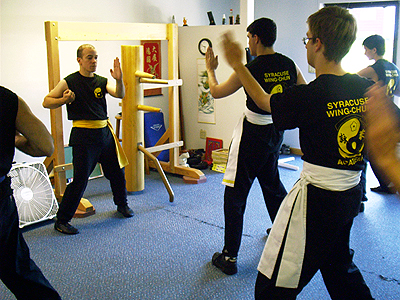its paid sponsors, whose products you need!
“Stay ‘unreasonable.’ If you
don’t like the solutions [available to you], come up with your
own.”
Dan Webre
The Martialist does not
constitute legal advice. It is for ENTERTAINMENT
PURPOSES ONLY.
Copyright © 2003-2004 Phil Elmore, all rights
reserved.
How Effective is Wing Chun?
By Phil Elmore
(Originally published in
MartialTalk magazine.
Special thanks are due to Bob Hubbard)
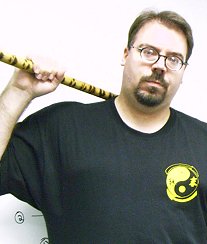 When
When
I started training in
Wing Chun Kung
Fu, I spent about three months wondering if the system was right for me. I
even contemplated quitting a few times, once going so far as to contact my
Sifu to speak with him about it. Wing Chun was different than most other arts
I had studied to that point; the footwork was precise and demanding, the horse
stance used for training was painful and seemed pointless, and
chi sao practice was so boring I thought it was a
complete waste of time.
My training to that point had been largely of the short attention span
approach, as I flitted from style to style without committing. Reluctant to
walk away from yet another school and worried that I was shortchanging myself
by never testing for advanced ranks, I told myself to give it at least six
months. That seemed like a fair amount of time in which to decide if the style
was right for me. If Im still hating it, if I still feel like the clumsiest
guy in class, Im not capable of learning it, I told myself.
Im very grateful I did not quit.
It was in those next weeks and months that things started to come together. I
got it as I trained, becoming more and more comfortable with the style and
its application. More importantly, I began to see gains that pointed to the
qualities I had observed in my Sifu: his incredible speed, his seemingly
effortless flow, the snap to his techniques, and the tremendous power he
generates in a body one hundred pounds lighter than mine.
While Wing Chun is not the only style I study, it has had a profound influence
on me. Ive come to realize just how effective
and efficient a close-quarters fighting art it is. Given my experience
with Wing Chun, the degree to which it is condemned, dismissed, and even
ridiculed by others surprises me though it shouldnt. Considering this, a
fundamental question remains in the minds of many. It is a question answered
derogatively by some whove spent years with the style, not to mention by the
occasional fly-by amateur who has dabbled in Wing Chun without truly learning
it as a system. The question is, Just how effective is Wing Chun?
I find myself, as a strong advocate of Wing Chun as a realistic fighting
system, defending a traditional martial art (TMA). This makes me, in the minds
of some critics, a traditionalist
though the fact is that I am as far from a traditionalist as it is possible
to be. I do not believe in defending tradition for its own sake, in holding up
age or the Ancients as proof of an argument. I do, however, believe in finding
value in the valuable wherever it may be, regardless of provenance.
I have no ego invested in Wing Chun as a system. If it had not met my
standards, I would not train in it and perhaps I would have felt a sense of
relief at the time this would free up in my schedule. I do not waste my time,
which is at a premium given my busy lifestyle, engaged in the illusion of
competence. This is why I know Wing Chun to be extremely effective because
I have experienced it personally, evaluated it objectively, and applied it
vigorously.
Of Lineages and Schools
Discussing the effectiveness of Wing Chun is complicated greatly by the fact
that not all Wing Chun is created equal. While I hate to admit it, the high
ratio of poor instruction to good instruction available commercially is
dismaying. There are multiple lineages of Wing Chun chains of students and
instructors, most of whom do things differently to varying degrees. (There is
even at least one lineage of Wing Chun not associated with the famous Wing
Chun master Yip Man.) Some lineages deemphasize, to their detriment, the
lateral footwork that makes Wing Chun mobile and therefore effective. Others
used flawed technical structure, such as tan saos (dispersing hands) or wu
saos (guarding hands) held horizontally rather than properly angled. (A tan
sao held horizontally has no deflecting power; a wu sao held horizontally is
in invitation to broken fingers.)
I train in the William Cheung lineage, but my instructor is a universalist who
believes that all Wing Chun should be respected as Wing Chun. He shows us
structural variations accordingly and lets us come to our own conclusions. All
lineages have their stories of how theirs is the true Wing Chun, all of them
apocryphal at best. These are irrelevant to me, for the efficiency of the
system is not built on these histories (despite the petty politicking that
occurs in the Wing Chun world).
A famous fight, which is still discussed today after years of bickering,
once took place between William Cheung and a student from another lineage. The
choppy video of this event is held up as proof of any number of spurious
claims. Cheung cant fight, is one. Cheung got his ass kicked, is another.
Wing Chun is not street effective, some conclude. Wing Chun people cant
grapple, some argue. Of these, only the latter has even a little validity,
though a single scuffle proves very little about the skills of those involved.
Anyone, after all, can screw up or have a bad day, and nobody is alert to
danger at all times (though they should be).
An objective look at the video (which both sides claim has been edited to the
benefit of the other) shows us that A) Cheung protects his center as hes been
taught to do; B) the aggressor mounts him and throws wild blow after wild
blow; C) Every time Cheung tries to throw a leg up over his opponent, he
slides across the gymnasium floor, providing the viewer with a valuable lesson
on the ways in which terrain can screw up our best laid plans.
When the fight was over, neither party was injured. So what does this tell
us? It tells us almost nothing. From it we learn nothing about Wing Chun as a
system (other than the need for cross-training in grappling to cover what is
arguably a blind spot in Wing Chun, though most schools do train in
anti-grappling). We learn relatively little about the two participants,
other than that they didnt hurt each other. We learn, simply, that politics
can leave a black eye on a style that no amount of punching can inflict.
I believe there is a right way and a wrong way to perform certain techniques,
even though some lineages teach the variations as acceptable. As always,
reality is the deciding factor. In my school, for example, we are taught to
distribute our weight evenly on both feet for optimum balance and mobility.
Anyone who tells you, therefore, that Wing Chun is ineffective because the
weight is placed primarily on the rear leg is in error though that error
may be the product of poor teaching in a lineage or school imparting improper
structure.
When we discuss the efficacy of Wing Chun, then, we must acknowledge that many
schools and lineages teach different things. Where there is conflict, we must
be biased towards those techniques and principles that offer the best
REALISTIC results. All else is not proof of Wing Chuns ineffectiveness it
is proof of poor teaching (or poor learning). The final arbiter is reality,
not claims or stories or family trees. Wherever a better alternative exists in
the pantheon of Wing Chun masters, it is that alternative that represents
true Wing Chun.

Just how effective is Wing Chun?
Train earnestly and youll find out.
Touch Reflexes and Sticky Hands
From the outset, I despised chi sao practice at my Wing Chun School. What was
the point, I wondered, of these repetitive, stylized movements? It was so
boring. These are common complaints and produce predictable proclamations from
students of reality-based self-defense instructors (and even students of other
TMAs). There are better ways to spend your time, they will state. There are
faster ways to learn effective self-defense.
While Wing Chun Kung Fu can be learned relatively quickly by the standards of
TMA, it is true that it is not the fastest means of acquiring immediate
self-defense skills. There are numerous combatives curricula available that
provide this (such as the Six Gates Defense
course my own Wing Chun instructor offers). Training in a martial art like
Wing Chun, however, implies a commitment to development over the long term
rather than in the short term.
Ive written before of the time I attacked my Wing Chun teacher with a
rubber knife and he missed the initial intercept of my blade. His touch
reflexes enabled him to perceive the force of my incoming attack and respond
accordingly despite the initial miss. No amount of conscious thought can
produce reflexes of this nature. When developed, touch reflexes are
instinctive and make the fighter much more formidable. This is why my
instructor can fight me without looking at me at least part of the time.
These are attributes that can only be developed over the long term. No number
of five-hour seminars will make you more sensitive in the short term. I
doubted the utility of chi sao until I loosened up and started seeing gains
at which point my strikes and my counters became faster and less conscious.
A student who dismisses the benefit of chi sao entirely does not understand
its purpose. Those who admit that touch reflexes are of benefit, but who argue
that there are better ways than sticky hands to develop it, are not
providing a convincing argument against chi sao. They are simply arguing for a
different means towards the same end.
Forms and Tradition
The practice of forms is closely associated with traditional Kung Fu and is
also dismissed by amateurs and experts alike. When I studied Chidokwan Karate,
I hated memorizing kata. A form is not a kata; the latter is a chain of
techniques performed against an imaginary opponent or opponents, normally
practiced with speed and power. A form, by contrast, is a physical catalog of
techniques a slow pantomime of what a style has to offer at the forms level
of development.
Syracuse Wing Chun Academy students
perform Sil Lim Tao.
Critics of forms, particularly Sil Lim Tao (the first form
of Wing Chun), complain that it is practiced slowly and with neither power nor
resistance. How, they demand, does this teach someone to fight?
A form does not teach the practitioner to fight. A form does teach proper
structure and, well, form for ones techniques. It teaches the right angles,
the proper distances, and the ranges of motion for those techniques. As a
means of practice it is very useful. No amount of forms practice can take the
place of combat drills, through which techniques are applied with speed and
power against resisting opponents. As a reference tool for the mechanics of
those techniques, however, the form serves a vital purpose in learning the
style.
As a mental exercise, forms allow the practitioner to internalize a physical
catalog of techniques and refer back to it. Frequently my Sifu will say, From
the form, referring to the right way to execute a movement. Repetition is the
best means of internalizing anything, while slow practice forces the
practitioner to focus. Done correctly, Sil Lim Tao takes an excruciatingly
long time to perform with good reason. Thus, the forms critics knock as
slow, repetitive, and useless are actually valuable teaching tools.
(Ive heard stories of schools that make students practice Sil Lim Tao for a
full year while teaching them nothing else, on the theory that this proves the
students dedication. This would be like learning to drive while memorizing
the manual but never once climbing into a car. It is also irrelevant to Wing
Chuns effectiveness once learned.)
As an aside, perhaps the stupidest critique Ive heard of forms is that there
is no need, in this day and age of DVD and digital cameras, for a physical
catalog of techniques. No student can afford to refer back to off-site
storage for a technique when the site in question is the brain of the
practitioner. A form is a tool, but to be useful it must be carried by the
user.
I watched a video online of some UFC-style tournament in which a wrestler
faced a Wing Chun practitioner (who was probably of a different lineage than
mine, judging by his low wu saos). The Wing Chun fighter walked towards his
opponent. He stood there like a potted plant while the wrestler performed a
shoot, took him down, and mounted him before pounding the living daylights out
of him. The video is another of those pieces of proof that Wing Chun is not
effective or so critics assert.
In reality, the video is again proof of either poor teaching or a poor
student. Even the beginners in my Wing Chun school are taught the importance
of lateral footwork, of moving off the attacking line, of moving in to
dominate space and overwhelm the opponent. My instructor often repeats the
mantra, Light on your feet, cant be beat. The footwork we learn is precise,
demanding, fast, and effective. In sparring with a friend from a hard style,
my Wing Chun footwork served me well, as I was able not once, but twice to
circle step around and in to strike him while avoiding kicks. Before my Wing
Chun training, I would not have accomplished this.
Done properly, Wing Chun footwork is balanced, stable, and a good structural
platform from which to generate power. We are taught to remain rooted while
moving, retaining balance while aligning the bodys gates to hit with power.
Wing Chun Chain Punching
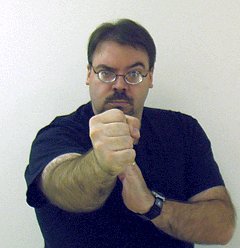 Ive
Ive
read some truly ignorant comments online regarding Wing Chuns punching
techniques, from the misconception that such punches rely on speed for power
to the assertion that centerline punches cannot be thrown with power. An
informed wing Chun student knows that the reciprocating centerline punches of
Wing Chun rely on the punching-side leg remaining rooted, while the leg, hip,
shoulder, and elbow line up to deliver force with pile-driving efficiency.
Beginners are generally slow at first, and practicing chain punches in the air
is done without power to develop the tendons over the long term. This leads,
however, to power-punching against focus pads and bags and ultimately to
students wearing Army-surplus flak jackets to absorb the impacts. The famous
one- and no-inch punch techniques are Wing Chun
punches. With practice, this phonebook parlor tick can be performed
instinctively in combat, as the student learns to align his or her body to
blast the opponent.
If I have any real complaints about Wing Chun punching, those complaints have
nothing to do with power. Wing Chun punches are exceptionally powerful when
performed correctly. No, my problem is that I generally do not like
closed-fist strikes at all because of the danger of damage to the hand.
Fortunately, Wing Chun also contains chops and palm strikes, which I tend to
favor. The vertical sun fist of Wing Chun punching is at least structurally
superior to the horizontal fists used in Karate styles (which I refuse to do
at all anymore). My instructor, who has extensive boxing experience, finds
closed-fist punching very natural. He hits HARD, too.
The Wooden Dummy
A lot of ignorant practitioners of fighting arts treat the wooden dummy like a
rigid heavy bag. Some go so far as to complain that the dummy is a
traditionalist failing of Wing Chun because it makes a poor punching
surface. All of these people are making a profound mistake. The wooden dummy
is used to train the all-important structure of Wing Chun techniques the
angles and orientations that make this art (whose practitioners refuse to
fight force with force) work. It can be
used for a limited amount of conditioning, but the wooden dummys primary
purpose is to provide reference points and feedback for the proper execution
of techniques. It is not intended for use as a target for absorbing blunt
trauma. A practitioner who brags about breaking the arms off his dummy does
not understand how to use it. A student who pounds the dummys body like a
heavy bag is ignorant and nothing else.
The wooden dummy trains structure. It is not a punching bag.
Power training in Wing Chun is performed with partners and
with proper padding and bags as in any art. Good schools integrate this
training in their programs.
Vicious Lowline Kicking
High kicks are a liability in any fight. Wing Chun practitioners kick no
higher than the groin or waist. Wing Chun kicks, when taught properly, are
fast, non-telegraphic, and brutal. Critics will perceive a lack of kicking
practice in the early stages of training, but this is due in part to the
rigidity of the curriculum in some schools. The first form of Wing Chun
contains no footwork and thus no kicks. Good Wing Chun schools give even
beginning students practice in the kicking techniques that make Wing Chun
especially brutal from the waist down.

Even beginning students practice kicking at good Wing Chun schools.
Simultaneous Blocking and Striking
Forget all the nonsense youve heard about trapping or whatever other
overcomplicated misconceptions you may have about Wing Chun. One of the core
principles of the system is to use both hands at the same time. Wing Chun,
in recognition of the fact that a strike beats a block every time, performs
both simultaneously. This is done by slapping, jamming, or jerking the
attacking limb while delivering a counterattack preemptively, when possible.
Wing Chun practitioners also learn to deliver rapid, vicious, powerful blows,
flowing into and over the opponent (preferably from the blind side as
facilitated by lateral footwork). The blocks themselves are, in fact,
painful strikes. One well-known Wing Chun instructors slapping block has, as
my instructor has witnessed, taken the hair off the attacking students arm.
My instructors pak saos (slapping hands) are extremely powerful and leave
my arms a pulsing red for minutes afterward.
Wing Chun striking is generally considered linear, though it has tight,
circular elements. Regardless, it is extremely efficient, which is its
hallmark. A good Wing Chun fighter strikes quickly and repeatedly, but with
the power to back up his attack thanks to the structure provided by his body
mechanics and footwork.
Space Domination and Reality Combat Mechanics
In my Wing Chun school, students are taught to deescalate conflict with body
language and verbiage that places the hands up, backs the practitioner away
from the threat, and protects the centerline in a casual approximation of the
Wing Chun guard. From here it is a quick transition to a strike or a more
formal guard, all while protecting ones personal space.
This is both a physical and mental exercise, for students learn the
appropriate statements to make to law enforcement after a fight, all while
indicating to any observers that they do not want trouble before the fact. If
the attack comes, the practitioners hands are already up where they belong.
Wing Chun fighters, when taught well, are also taught to strike preemptively
when a credible threat presents itself within attacking range. They
learn to close quickly when on the attack and to
continue pressing to overwhelm the assailant. This is the essence of
reality based fighting. It is, in short, ruthless and effective.
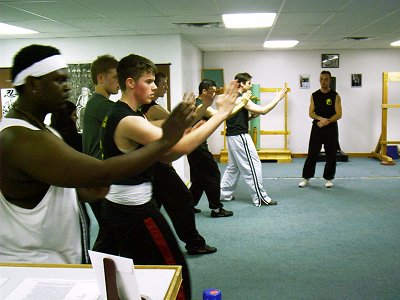
Students learn footwork to close efficiently and quickly.
Combat Drills and Realism
The training and the principles come together to combine with the students
developing attributes in the combat drills of Wing Chun. More realistic than
the low-contact dueling that is much sparring, combat drills enable students
(properly padded when necessary) to train techniques full-speed, with full
intent, against resisting opponents. A typical series of combat drills in our
school takes place in the circle of death,
a training tool we use that pits students of all sizes and experience levels
against each other. At other times, students in my Wing Chun school learn
defenses against knives and guns as well
as street smart defenses against common attacks.
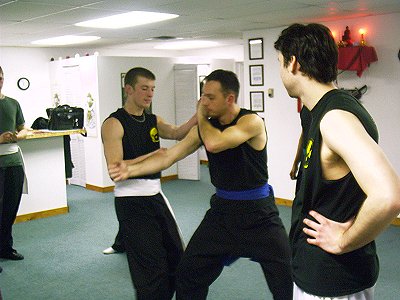
Combat drills in the Circle of Death offer training
that is more realistic than sparring.
Centerline Awareness
All of this leads to the central tenet of Wing Chun: centerline awareness.
Wing Chun practitioners are obsessive about guarding the centerline, moving
off the attacking line, and striking from the opponents blind side whenever
possible. This is sound, effective fighting principle. Wing Chun ingrains
centerline awareness indelibly.
How Effective is Wing Chun?
Taught properly, Wing Chun is an extremely efficient, effective art that is
entirely compatible with military combatives and reality based fighting
techniques. Not everyone who tells you otherwise is pontificating from
ignorance but many are. While a great many schools teach what I consider to
be poor structure or less than ideal curricula, there are many very good
schools out there. I am fortunate that mine is one of them.
The Wing Chun I know is fast, mobile, and powerful. It is rooted firmly in the
reality of combat. It is an efficient, pragmatic fighting art, the mastery of
which would serve anyone well.
It is, in a word,
effective.

